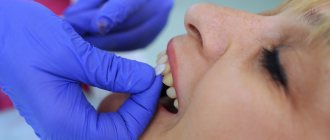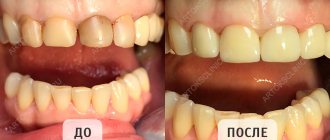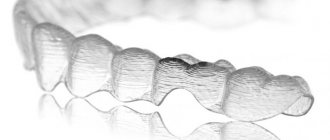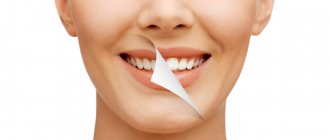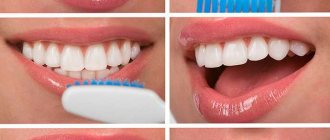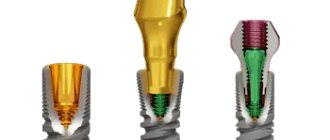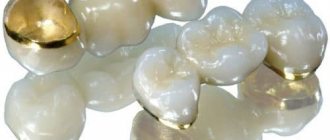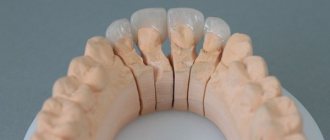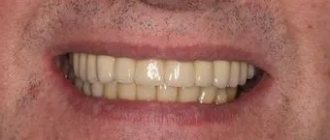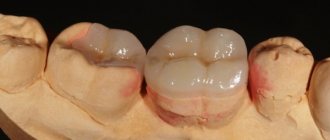Direct restorations using the sandwich technique of the posterior group of teeth are an aesthetically effective and cost-effective method for restoring hard tissue defects. But in the vast majority of cases, composite materials are used.
L. A. Lobovkina
Ph.D., doctor of the highest category, head of the treatment and prophylactic department of Branch No. 6 of the Federal State Institution “GVKG im. Burdenko" of the Ministry of Defense of the Russian Federation
A. M. Romanov
Candidate of Medical Sciences, Chief Physician of the Implamed Clinic (Moscow)
Composites pros and cons
Currently, in most cases, composite materials are used for direct dental restoration. In cases with large restorations, the adhesion of the composite to the tooth enamel helps to re-strengthen its structure, unlike metal restorations, which do not have the same benefits. However, along with their advantages, they have a number of disadvantages: polymerization shrinkage and deformation of large-volume fillings over time, insufficient biocompatibility with hard dental tissues, lack of a cariesstatic effect, and high cost [3]. In addition, taking into account the peculiarities of the anatomical structure of dentin and its insufficient mineralization, composites are not recommended for use in children and adolescents (under 14 years of age).
Dental sandwich plastic surgery with bone block
To understand why bone grafting is needed, you need to understand the causes of tissue deficiency. Tissue atrophy (reduction in volume) can be caused by infectious diseases, injuries, and periodontal pathologies.
A common cause of atrophy is tooth extraction. If the patient postpones a visit to the implantologist until later, the bone tissue begins to rapidly decrease (up to 25% of the previous volume per year). It is not surprising that this amount of tissue is not enough to firmly fix the implant, and the doctor has to create additional volume on his own. Bone grafting prior to implantation eliminates uneven physical load and does not allow the implant to become loose and fall out.
Our clinic’s specialists have extensive experience and dozens of proven techniques related to the restoration of bone tissue, both in width and height.
Will GIC replace it?
Considering the above, more attention should be paid to glass ionomer cements (GIC), which have physical and chemical affinity for hard dental tissues [1, 2]. Due to its diffusion-based adhesion to both healthy and partially demineralized dentin, glass ionomer cement is an ideal cavity sealing material, preventing access to bacterial nutrients and reducing any colonies remaining in the cavity to a latent state. It has also been proven that fluoride and other apatite-forming ions can penetrate carious dentin to a significant depth, thereby remineralizing it [4].
Considering the peculiarities of the anatomical structure of dentin and its insufficient mineralization, composites are not recommended for use in children and adolescents (under 14 years of age).
How to restore a large cavity?
In the practice of a dentist, significant difficulties often arise when restoring teeth with large carious cavities extending under the gum, as well as when restoring hard tissues due to defects in the neck or root of the tooth. Since composites are hydrophobic materials (i.e., they are afraid of the presence of moisture), it is impossible to achieve their good adhesion to the hard tissues of the tooth in the above cases [3].
Therefore, in some cases it is more expedient to use the sandwich technique, which consists in using GIC in combination with composite materials. In addition, in patients with a “problematic” oral cavity (those with a low level of hygiene, a high level of CP and a high incidence of “recurrent” caries), they can be used independently.
Disadvantages of GIC
It is advisable to note that, along with the positive characteristics of GIC, they have a significant drawback - high opacity, which does not allow obtaining highly aesthetic restorations when using only these materials.
In this regard, companies producing dental materials are looking for ways to improve GICs, including increasing their aesthetics.
The rationality of sandwich technology
In some cases, it is more expedient to use the sandwich technique, which consists in using GIC in combination with composite materials.
The use of such translucent reactive glass provides the material with better aesthetics compared to its analogues by reducing opacity and increasing transparency. Therefore, given the very similar physical and handling characteristics of modern condensed glass ionomers, the choice of material for restoration should be made taking into account its aesthetics.
In addition, another advantage of Ionofil Molyar is the convenience of its application and ease of adaptation to the bottom and walls of the cavity. It also has a low cost. Thus, one restoration (depending on the size of the cavity to be filled) costs an average of 20-40 rubles in material, which makes this cement quite affordable even for budgetary medical institutions.
It has also been proven that fluoride and other apatite-forming ions can penetrate carious dentin to a significant depth, thereby remineralizing it.
Modern methods of caries treatment
Treatment of caries, dentistry offers more modern methods, subject to the initial and middle stages of the disease. They help stop the process of tooth decay and also help eliminate the cause.
The difference between modern methods of dental treatment is that the affected areas are removed without affecting healthy ones. In addition, the technologies do not include the use of boron; for this purpose, other methods of influencing areas affected by caries are used. The most popular methods are ozone, air-abrasive, infiltration and laser treatments. Such methods help not only to get rid of the disease, but also to prevent its occurrence.
If the patient has a deep stage of destruction, then treatment includes special modes of cleaning the tooth cavity with the application of a gasket under the filling material.
If it is possible to preserve the nerve, the specialist takes measures to prevent the recurrence of caries. These actions include:
- Taking into account the anatomical structure of the tooth, it is prepared with a bur.
- In order to prevent opening of the pulp chamber, the treatment of the carious cavity occurs with alternating low and high speeds of the tips.
- Caries detectors are used to identify carious areas.
- To protect the tooth from overheating, air-water cooling is used.
- Spacers are used to isolate the nerve of the tooth.
Treatment of caries involves more than one visit to the dentist, which will allow you to control the process of exposure to medications.
Sandwich technique
To achieve the most durable result when filling, several types of material are used at once, highlighting the positive aspects of each. Sandwich technology has a similar technique, it helps eliminate the disadvantages of many filling materials, such as bioincompatibility, shrinkage or deformation, for this purpose glass ionomer cements, as well as composites, amalgams and compomers are added to the filling material.
The application of gaskets made from these filling materials occurs in the following ways:
- open: the gasket covers one wall, there is contact with the oral environment;
- closed: there is no contact between the oral fluid and the edges of the cavity with the lining.
This filling technique allows:
- get rid of subgingival and cervical defects, in particular with carious destruction of the tooth root;
- stop the process of microbial proliferation;
- achieve naturalness due to the natural color of the filling;
- reduce shrinkage of filling material;
- The development of secondary caries is prevented due to the therapeutic effect of the lining.
Air abrasive method
The method is based on treating the damaged area with a sandblaster, which is used for professional cleaning of the oral cavity. During the procedure, mechanical treatment of teeth occurs by knocking out tissues destroyed by caries with a stream of air containing various impurities. Quartz sand was previously used as an admixture; later it was replaced with aluminum oxide, which does not change the color of the enamel and does not have a toxic effect. This method allows you to remove carious tissue without affecting healthy tissue. After such treatment, the risk of recurrent caries development is eliminated. The procedure is performed without anesthesia, is safe and painless, since there is no heating or vibration effect on the tooth. Air supply occurs in pulses of 6-10 seconds.
The disadvantage of the air-abrasive method is that it increases tooth sensitivity after the procedure; it is also not suitable for treating carious plaque in hard-to-reach places.
Infiltration
This method allows for dental treatment without the use of a drill. Indicated for caries caused by wearing braces or for removing carious lesions at the initial stage. A gel substance is applied to the affected surface, which can split part of the enamel. The tooth is dried with a stream of air and ethyl alcohol, after which the dentist treats it with a polymer resin.
One of the advantages of infiltration is that the procedure lasts no more than 20 minutes and there is no pain. It is worth noting that this method is only applicable to areas between the teeth and on the smooth surface of the teeth. A well-performed procedure will prevent the development of caries for many years to come.
Sandwich technique on a chewing tooth [Clinical Example]
Patient T., 24 years old, came to the dental clinic with complaints of short-term pain from temperature stimuli in the area of the 4.7 tooth (Fig. 1). An objective examination of tooth 4.7 revealed a restoration that did not meet clinical requirements. Considering that the patient had a low level of caries resistance of hard dental tissues, as well as a significant cavity volume, the sandwich technique was chosen for treatment.
Rice. 1. Tooth 4.7: initial clinical situation.
Conductive anesthesia UbistesiniForte 1.5 ml was performed, the tooth surfaces were cleaned of pellicles with Clint paste (VOCO), and the color of the future restoration was determined. A rubber dam was applied, the failed restoration was removed, and a cavity was formed. After medicinal treatment of the cavity with a 2% chlorhexidine solution, a basic gasket from the Ionofil Molar GIC was applied (Fig. 2).
Rice. 2. A gasket made of GIC “Ionofil Molyar” was applied.
Next, adhesive preparation of the cavity was carried out and its restoration was carried out using the Grandio nanohybrid composite (VOCO), which has reduced polymerization shrinkage, improved physical and mechanical characteristics and the highest color stability. Then the rubber dam was removed and the restoration was finished (Fig. 3).
Rice. 3. Tooth 4.7: final appearance after restoration.
Double-curing glass ionomer cement “Ionolux” (VOCO, Germany), which appeared relatively recently on the dental market, has already won the love of many dentists. Ionolux combines glass ionomer and composite parts, which determine its excellent properties.
Thus, due to the composite component, its aesthetic qualities have improved, the possibility of immediate finishing has become possible immediately after polymerization, the formation of a chemical bond with composites and very low solubility in water have been noted.
Unlike analogues, when working with Ionolux, there is no need for adhesive preparation of hard dental tissues (for example, there is no stage of priming of hard tissues), since it is a self-adhesive cement. It is well known that the more curing mechanisms a GIC has, the less fluoride ions it releases into surrounding tissues. However, in terms of the release of fluorine ions, Ionolux is not inferior to classical GIC.
What types of light-curing composites are there?
Light-curing composites vary in structure and can be dense and “flowable”. There are many types of photopolymer fillings for teeth, but each of them necessarily contains three components: a polymer organic matrix, an inorganic filler and silane (a link between the organic and inorganic elements of the filling material).
Example of sandwich technique in the first molar [Clinical Example]
Patient L., 23 years old, came to the dental clinic with complaints of spontaneous pain at night, aggravated by the action of temperature stimuli in the area of the 3.6 tooth. An objective examination of tooth 3.6 revealed a carious cavity filled with food debris and softened dentin. On probing there is sharp pain at one point. First, endodontic treatment was performed (Fig. 4).
Rice. 4. Tooth 3.6 after endodontic treatment.
Considering the presence of a large cavity in the patient, the sandwich technique was chosen for treatment (Fig. 5). Next, adhesive preparation of the cavity and its restoration with the Grandio nanohybrid composite were carried out. After removing the rubber dam, macro- and microcontouring of the restoration was performed.
Rice. 5. A gasket made of GIC “Ionolux” was applied.
For this purpose, low and ultra-low abrasiveness peaked and flame-shaped diamond burs (SSWhite) were used, as well as Dimanto universal polishing heads (VOCO) with an air-water spray without polishing paste (Fig. 6). The final appearance of the restoration of tooth 3.6 is shown in Figure 7.
Rice. 6. Tooth 3.6: polishing stage using a Dimanto polishing head.
Rice. 7. Tooth 3.6: final appearance after restoration.
How it is made
The manufacturing process of a denture of this model is very complex, so the devices are used only in high-level clinics.
The production of the prosthesis is carried out in special laboratories, according to a previously made impression of the jaw of the patient who is undergoing the procedure of replacing teeth with prostheses. The technology for performing the process is unknown, since it is protected by a patent and has not been declassified. After the design is made, the patient is invited to the dentist for a fitting.
During the visit, the finished product is tried on for the patient. If shortcomings and inconveniences in wearing the design are found, it is sent for revision. If the design is ideal in size and shape, the patient is given a form with advice on caring for the dentures to ensure a longer service life.
Using the JIC [Conclusions]
Along with the positive characteristics of GIC, they have a significant drawback - the high opacity of the material, which affects the final result of the restoration.
Thus, restoration of defects in the area of the lateral group of teeth using a composite is a very popular method of treating caries. However, we should not forget that in a number of clinical situations the sandwich technique is more preferable. In addition, the sandwich technique used in these clinical cases provides not only a therapeutic effect, but also reduces the cost of restoration due to less use of more expensive composite material, which is especially important during the economic crisis.
https://dentalmagazine.ru/
When are dental fillings placed?
A filling is placed on a front or chewing tooth when it is necessary to reconstruct enamel and dentin damaged as a result of caries, non-carious destruction or trauma. In these cases, filling is advisable if no more than a third of the crown is lost - in the treatment of dental diseases and to improve the aesthetics of the dentition.
